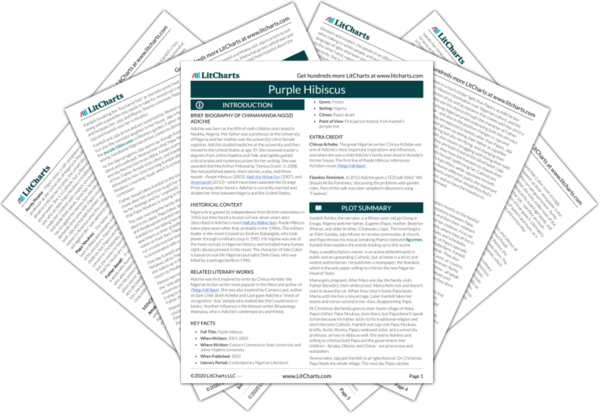Welcome to the LitCharts study guide on Chimamanda Ngozi Adichie's Purple Hibiscus. Created by the original team behind SparkNotes, LitCharts are the world's best literature guides.
Purple Hibiscus: Introduction
A concise biography of Chimamanda Ngozi Adichie plus historical and literary context for Purple Hibiscus.
Purple Hibiscus: Plot Summary
A quick-reference summary: Purple Hibiscus on a single page.
Purple Hibiscus: Detailed Summary & Analysis
In-depth summary and analysis of every chapter of Purple Hibiscus. Visual theme-tracking, too.
Purple Hibiscus: Themes
Explanations, analysis, and visualizations of Purple Hibiscus's themes.
Purple Hibiscus: Quotes
Purple Hibiscus's important quotes, sortable by theme, character, or chapter.
Purple Hibiscus: Characters
Description, analysis, and timelines for Purple Hibiscus's characters.
Purple Hibiscus: Symbols
Explanations of Purple Hibiscus's symbols, and tracking of where they appear.
Purple Hibiscus: Theme Wheel
An interactive data visualization of Purple Hibiscus's plot and themes.
Brief Biography of Chimamanda Ngozi Adichie
Adichie was born as the fifth of sixth children and raised in Nsukka, Nigeria. Her father was a professor at the University of Nigeria and her mother was the university’s first female registrar. Adichie studied medicine at the university and then moved to the United States at age 19. She received master’s degrees from Johns Hopkins and Yale, and rapidly gained critical praise and numerous prizes for her writing. She was awarded the MacArthur Fellowship “Genius Grant” in 2008. She has published poems, short stories, a play, and three novels—Purple Hibiscus (2003), Half of a Yellow Sun (2007), and Americanah (2013)—which have been awarded the Orange Prize among other honors. Adichie is currently married and divides her time between Nigeria and the United States.
Get the entire Purple Hibiscus LitChart as a printable PDF.

Historical Context of Purple Hibiscus
Nigeria first gained its independence from British colonialism in 1960, but then faced a brutal civil war seven years later (described in Adichie’s novel Half of a Yellow Sun). Purple Hibiscus takes place years after that, probably in the 1980s. The military leader in the novel is based on Ibrahim Babangida, who took power through a military coup in 1985. His regime was one of the most corrupt in Nigerian history, and included many human rights abuses present in the novel. The character of Ade Coker is based on real-life Nigerian journalist Dele Giwa, who was killed by a package bomb in 1986.
Other Books Related to Purple Hibiscus
Adichie was first inspired to write by Chinua Achebe, the Nigerian fiction writer most popular in the West and author of Things Fall Apart. She was also inspired by Camara Laye, author of Dark Child. Both Achebe and Laye gave Adichie a “shock of recognition” that “people who looked like [her] could exist in books.” Another influence is the Kenyan writer Binyavanga Wainaina, who is Adichie’s contemporary and friend.
Key Facts about Purple Hibiscus
- Full Title: Purple Hibiscus
- When Written: 2001-2003
- Where Written: Eastern Connecticut State University and Johns Hopkins University
- When Published: 2003
- Literary Period: Contemporary Nigerian Literature
- Genre: Fiction
- Setting: Nigeria
- Climax: Papa’s death
- Point of View: First person limited, from Kambili’s perspective
Extra Credit for Purple Hibiscus
Chinua Achebe. The great Nigerian writer Chinua Achebe was one of Adichie’s most important inspirations and influences, and when she was a child Adichie’s family even lived in Achebe’s former house. The first line of Purple Hibiscus references Achebe’s novel Things Fall Apart.
Flawless Feminism. In 2012 Adichie gave a TED talk titled “We Should All Be Feminists,” discussing the problems with gender roles. Part of this talk was later sampled in Beyonce’s song “Flawless.”












